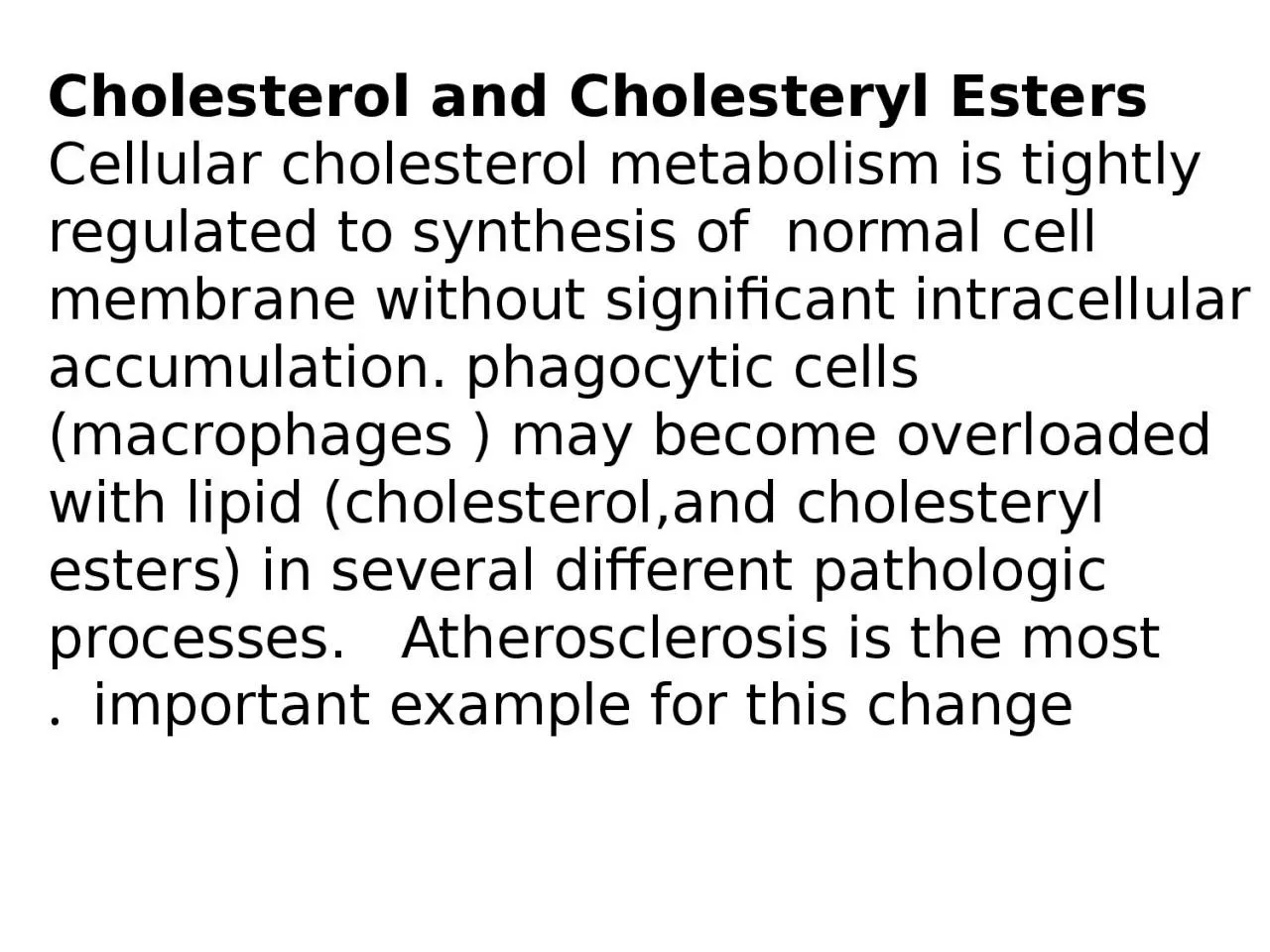

Esters Cellular cholesterol metabolism is tightly regulated to synthesis of normal cell membrane without significant intracellular accumulation phagocytic cells macrophages may become overloaded with lipid ID: 1034937
Download Presentation The PPT/PDF document "Cholesterol and Cholesteryl" is the property of its rightful owner. Permission is granted to download and print the materials on this web site for personal, non-commercial use only, and to display it on your personal computer provided you do not modify the materials and that you retain all copyright notices contained in the materials. By downloading content from our website, you accept the terms of this agreement.
1. Cholesterol and Cholesteryl EstersCellular cholesterol metabolism is tightly regulated to synthesis of normal cell membrane without significant intracellular accumulation. phagocytic cells (macrophages ) may become overloaded with lipid (cholesterol,and cholesteryl esters) in several different pathologic processes. Atherosclerosis is the most important example for this change .
2. Hyaline change Is histological or cytological alterations characterized by glassy homogeneous material appear as eosinophilic in H&E staining section . It may be intracellular or extracellular .Intracellular hyaline change - mainly seen in epithelial cells e.g1- Hyaline droplets in proximal convoluted epithelial cells in case of excessive re absorption of plasma protein. 2- Hyaline degeneration of rectus abdomenalis muscle called Zenker s degeneration , occurring in typhoid fever
3. 3-Mallory s hyaline is aggregates of intermediate filaments in the hepatocytes in case of alcoholic liver 4- Russell s bodies excessive accumulation of immunoglobulin's in plasma cells.
4. Intracellular hyaline as Russell s bodies in cytoplasm of plasma cells
5. Extracellular hyaline is seen in connective tissues.Examples of extracellular hyaline change as :-1- Hyaline degeneration in leiomyomas of the uterus. 2- Hyalinised old scar of fibro- collagenous tissues.3- Hyalinised glomeruli in chronic glomerulonephritis.4- Hyaline arteriosclerosis in renal vessels in hypertension and diabetes mellitus.
6. Extracellular hyaline deposit in leiomyoma uterus
7. Hyaline arteriolosclerosis. The arteriolar wall is hyalinized and the lumen is markedly narrowed
8. Mucoid degeneration There is a change characterized by accumulation of mucin in intracellular and extracellular loci.Mucin is a glycoprotein secreted by mucous glands .Epithelial mucin examples 1- Catarrhal inflammation of mucous membrane of respiratory tract ;alimentary tract ;and uterus . 2- Obsruction of duct leading to mucocele in the oral cavity . of ovary ; stomach ;and large bowel. tumor Secreting 3- mucin4- fibrosis of the pancreas .
9. intra cytoplasmic Mucinous material in epithelial cell of ovary
10. Connective tissue mucinExamples of disturbance of connective tissue mucine :- 1- mucoid degeneration in some tumours e.g. myxomas ; neurofibroma; fibroadenoma; and soft tissue sarcoma.2- dissecting aneurysm of the aorta.3- myxomatous change in the dermis.
11. Myxoid change in neurofibroma
12. Amyloid degeneration Amyloidosis results from abnormal folding of proteins , which are deposited as fibrils in extracellular tissues and disrupt normal function due to inherited and inflammatory disorders . Pathogenesis Normally, misfolded proteins are degraded intracellularly in proteasomes, or extracellularly by macrophages. In amyloidosis, these quality control mechanisms fail, allowing the misfolded protein to accumulate outside cells. Misfolded proteins often are unstable , ultimately leading to the formation of fibrils that are deposited in tissues. .
13. Schematic diagram of an amyloid fiber showing fibrils (4 shown, may be up to 6)
14. Classification of amyloidosis A- based on cause 1- primary 2- secondary B- based on extent of amyloidosis 1- generalized involving multiple organs2- localized involve one or two organs or sitesC-based on clinical location1- pattern I involving tongue ;heart bowel ; skeletal muscle ; skin and nerve 2- pattern II involving liver; spleen ;kidney ; and adrenals.3- mixed pattern involved of both pattern I and II.
15. D- based on tissue in which amyloid is deposited 1- mesenchymal organs derived from mesoderm.2- parenchymal organs derived from ectoderm and endoderm .E- based on precursor biochemical protein in to spicific serum amyloid protein.
16. Morphologic feature of amyloidosis-Grossly1- the affected organ enlarged ;pale ; and rubbery.2- cut surface show firm ;waxy ; and translucent parenchyma.- Microscopically1- the deposits of amyloid are found in extracellulr locations initially in the wall of small blood vessels.2- the deposits are in large amount causing microscopic changes and effects of pressure atrophy .
17. Amyloidosis of kidneys shows small ;pale ; waxy kidneys
18. Amyloid deposits are seen in glomerular capillry tuft and in peri tubular connective tissue cause atrophy of tubules of kidney
19. The spleen appear as pale and waxy appearance
20. Amyloid material seen in red pulp causing atrophy of white pulp
21. Amyloid deposits cause pressure atrophy of hepatocytes
22. Pathologic pigmentsPigments are colored substances that are either exogenous, coming from outside the body , such as carbon or endogenous, synthesized within the body itself. Endogenous pigments include lipofuscin , melanin , and certain derivatives of hemoglobin. 1-Lipofuscin, or "wear-and-tear pigment," is an insoluble brownish-yellow granular intracellular material that accumulates in a variety of tissues (particularly the heart, liver, and brain) as a function of age or atrophy .
23. 2-Melanin is, brown-black pigment that is synthesized by melanocytes located in the epidermis and acts as a screen against harmful ultraviolet radiation.Although melanocytes are the only source of melanin, adjacent basal keratinocytes in the skin can accumulate the pigment (e.g., in freckles). 3- Hemosiderin is a hemoglobin-derived granular pigment that is golden yellow to brown and accumulates in tissues when there is a local or After lysis of the erythrocytes at the site of hemorrhage, the red cell debris is phagocytosed by macrophages; the hemoglobin content is then catabolized by lysosomes with accumulation of the heme iron in hemosiderin.
24. exogenous pigmentThe most common exogenous pigment is 1- inhaled pigments :-A- pneumoconiosis:- asbestos fibers and silica dusts. B-anthracosis deposition of coal.2- injected pigments (tattooing ):- Indian ink and carbon deposit in dermis.